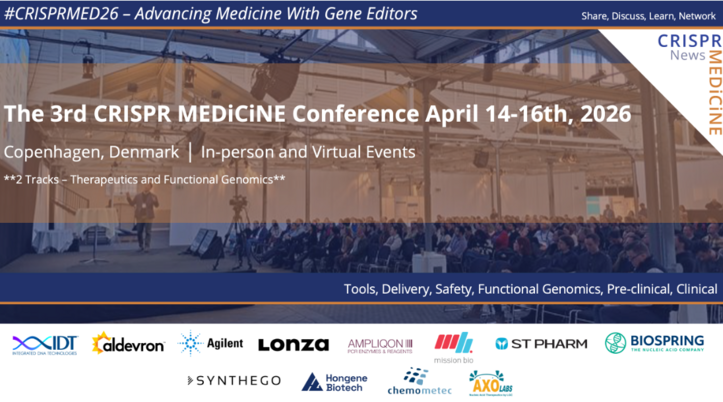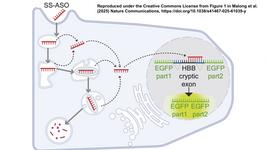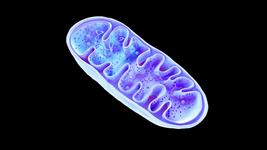CMN Weekly (04 July 2025) - Your Weekly CRISPR Medicine News
By: Billie Pang - Jul. 4, 2025
Top picks
- Precision gene editing medicine makes history, and it’s just getting started - Nature Biotechnology published an article this week by Laura DeFrancesco highlighting the emerging clinical promise of base and prime editing technologies. This article describes the life-saving base editing therapy that was used to treat a 7-month-old baby, baby KJ, with a fatal urea cycle disorder. These tools, more precise than traditional CRISPR-Cas9, avoid double-strand breaks and can correct single-nucleotide mutations. Several early trials have shown encouraging results across a range of diseases from sickle cell and hypercholesterolemia to chronic granulomatous disease. Despite logistical and regulatory challenges, these technologies could eventually benefit far broader patient populations and present revolutionary treatment options.
- In a recent Nature Communications publication researchers have developed a new method for optically controlling CRISPR-Cas activity using photocleavable phosphorothioate DNA (PC&PS DNA), offering a universal and programmable approach without the need for complex protein or gRNA engineering. Dubbed DNACas, the technique silences CRISPR function through affinity binding of PC&PS DNA and is restored through light-triggered chemical bond cleavage. The platform was shown to work across multiple CRISPR enzymes, enabling light-controlled one-pot LAMP-BrCas12b diagnostics and spatiotemporal gene editing.
Research
- This week in Nature Communications, researchers in Korea published a paper on engineered Sdd7 cytosine base editors (CBEs). They developed two variants, Sdd7e1 and Sdd7e2, which showed improved specificity and on-target efficiency. The group further reported that delivering these CBEs via engineered virus-like particles (eVLPs) further enhanced their specificity, offering a novel method for safer and more effective CBE delivery.
- A group of researchers have published a study presenting an alternative treatment option for anti-neutrophil cytoplasmic autoantibody (ANCA)–associated vasculitides (AAVs), a group of life-threatening systemic autoimmune diseases. The study published in Kidney International this week demonstrated effective depletion of the autoantigen protein SP3 using ex vivo CRISPR-Cas9 guided gene editing to eliminate the PR3 autoantigen. This new approach could present an alternative treatment option to suppressing the autoimmune response to PR3.
- In a new study in Nature Communications exploring CRISPR-Cas9 kinetics, researchers uncover why Cas9 from Streptococcus pyogenes functions as a single-turnover enzyme, limiting its efficiency in gene editing. Using truncated guide RNAs and kinetics-guided cryo-EM, the team captured the first structural snapshots of Cas9 dissociating from cleaved DNA. While the PAM-distal product releases post-cleavage, the tightly bound PAM-proximal fragment hinders target re-binding. These findings reveal key molecular roadblocks to Cas9 turnover and offer a blueprint for engineering more efficient genome editing enzymes.
- A recent publication by Nature Communications describes Context-Seq, a CRISPR-Cas9 targeted long-read sequencing method, to better track antimicrobial resistance gene (ARG) exchange between animals and humans. Applied in Nairobi, Kenya, Context-Seq revealed genetically similar AMR elements containing the ARGs blaCTX-M and blaTEM shared across humans, poultry, and dogs within and between households. It also identified potentially pathogenic hosts like E. coli, K. pneumoniae, and H. influenzae. Context-Seq may aid in precisely understanding how and to what extent antimicrobial resistance is exchanged between animals and humans and subsequently inform mitigation strategies.
Screening
- A genome-wide CRISPR screen identified AP1M1 and TBC1D23 as significant modulators of anti-sense oligonucleotide (ASO) activity through endosomal trafficking. Researchers demonstrated that AP1M1 knockout enhances ASO activity by delaying endosome-to-lysosome transport and increasing their ability for cytoplasmic escape. Conversely, TBC1D23 knockout reduced ASO efficacy by disrupting AP-1 vesicle tethering at the trans-Golgi network. The findings suggest that manipulating endolysosomal pathways could enhance therapeutic ASO delivery by preventing lysosomal degradation.The Nature Communicationsstudy was covered previously by CRISPR Medicine news. Read more in the CMN article here.
- An in vivo genome-wide CRISPR activation screen identified BACE1 as a key driver of brain metastasis in non-small cell lung cancer (NSCLC). Up to 40% of NSCLC patients develop brain metastases, but the genetic drivers remain poorly understood. The study published by Science Translational Medicine shows that activating BACE1 significantly increased metastatic burden, while its inhibition, both genetically and pharmacologically, suppressed brain spread in a patient-derived NSCLC model. These findings shed light on a novel mechanism of NSCLC brain metastasis and suggest BACE1 as a promising therapeutic target.
Industry
- CRISPR Therapeutics, one of the companies behind the groundbreaking therapy CASGEVY®, has been recognised as a Pioneer in the Times TIME100 Most Influential Companies of 2025.
- AvenCell Japan has been awarded up to $40 million in non-dilutive funding from the Japan Agency for Medical Research and Development (AMED) to advance AVC203, a dual-antigen (CD19/CD20) allogeneic CAR-T therapy for B-cell lymphomas. The IND-stage programme leverages AvenCell’s proprietary gene-editing platform designed to prevent immune rejection while preserving donor T-cell potency.
Reviews
- CRISPR-based diagnostics are emerging as powerful tools for rapid, point-of-care detection of single nucleotide variants (SNVs), crucial for diagnosing genetic diseases and tracking pathogens. This review published by Communications Medicine examines strategies to enhance CRISPR-based diagnostic specificity for SNV detection such as gRNA design and optimised reaction conditions, while highlighting the need for tailored optimisations. This review discusses future advances using AI-driven guide design and novel CRISPR systems that promise to boost precision and broaden clinical applications.
- A systematic review covering a decade of CRISPR research in cancer from 2014 to 2024 reveals a surge in publications, peaking before a slight decline post-2023. China and the U.S. led global output, with Harvard and Dana-Farber among the top institutions. Studies most frequently targeted breast and colorectal cancers. This review, published by Discover Oncology underscores CRISPR’s growing role in oncology and calls for the continued research into precision and safety as well as advanced optimisation.
- Mitochondrial DNA damage drives neuronal death and underlies neurodegenerative diseases like Parkinson’s, Alzheimer’s, and ALS. Emerging mitochondrial base editing tools such as zinc finger nucleases and cytosine base editors offer new avenues for repairing these defects. This review, published by Genes & Diseases, highlights recent advances in mitochondrial DNA editing and its potential to transform prevention and treatment strategies for neurodegeneration.
- A new Experimental & Molecular Medicinereview highlights how CRISPR-based perturbomics is accelerating the discovery of gene function, particularly for poorly characterised human genes. By linking gene modulation to phenotypic changes, these high-throughput screens have revealed therapeutic targets for cancer, cardiovascular disease, and neurodegeneration. Recent advances now allow more precise, single-cell-level analyses, pushing the boundaries of functional genomics and regenerative medicine.
- A recent Clinical and Experimental Medicine review highlights the growing impact of epigenetic therapies in treating haematological malignancies such as acute myeloid leukaemia and myelodysplastic syndromes. Focusing on DNA methylation and histone modifications, researchers outline how these changes disrupt gene regulation and drive leukaemogenesis. Therapeutic advances including DNA methyltransferase inhibitors, histone deacetylase inhibitors, and emerging CRISPR-based epigenetic editing tools offer new hope for reversing these alterations. The review emphasises the importance of continued research to fully harness epigenetic interventions in haematology.
News from CRISPR Medicine News
2 keynote speakers are now confirmed for CRISPRMED26, April 14-16th, 2026. Take a sneak peek at the early confirmed speakers here, and stay tuned for the official website going live next week!
Billie Pang is a computational biologist and science writer/communicator based in Dublin, Ireland.
To get more CRISPR Medicine News delivered to your inbox, sign up to the free weekly CMN Newsletter here.
Tags
ArticleNewsCMN WeeklyAvenCell TherapeuticsCRISPR Therapeutics AGVertex Pharmaceuticals, Inc.
CLINICAL TRIALS
IND Enabling
Phase I
Phase II
Phase III
Recurrent or Progressive High-grade Glioma, (NCT06737146)
Sponsors:
Suzhou Maximum Bio-tech Co., Ltd.
Sponsors:
Suzhou Maximum Bio-tech Co., Ltd.
IND Enabling
Phase I
Phase II
Phase III
Advanced Peritoneal Malignancies or Abdominal Metastatic Solid Tumors, (NCT06912152)
Sponsors:
Zhejiang University
Sponsors:
Zhejiang University
IND Enabling
Phase I
Phase II
Phase III







